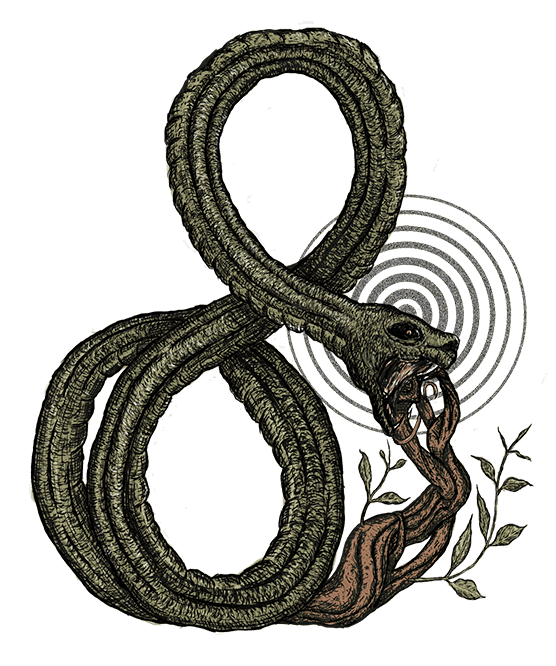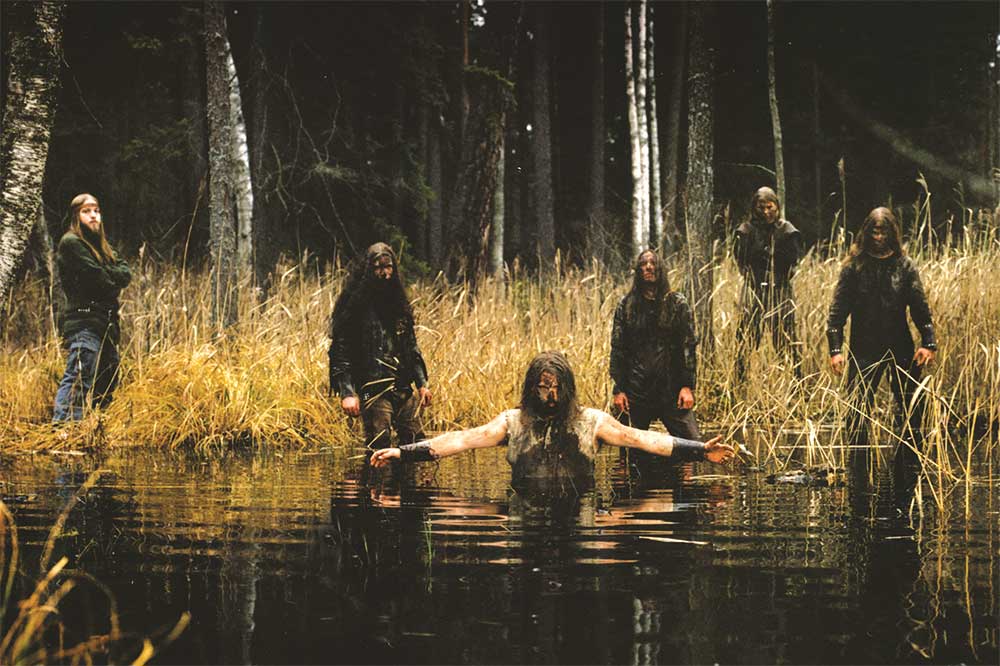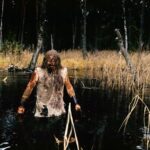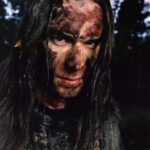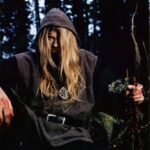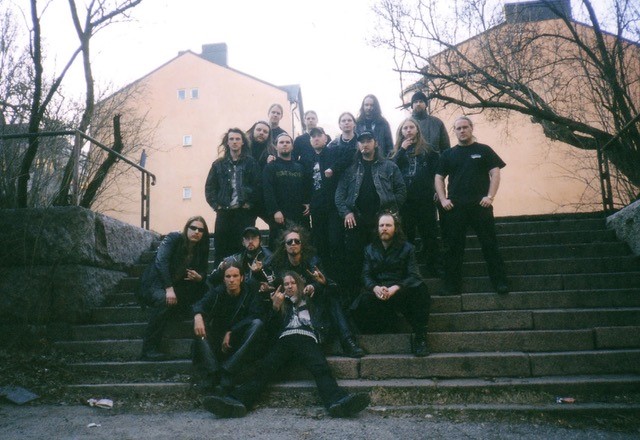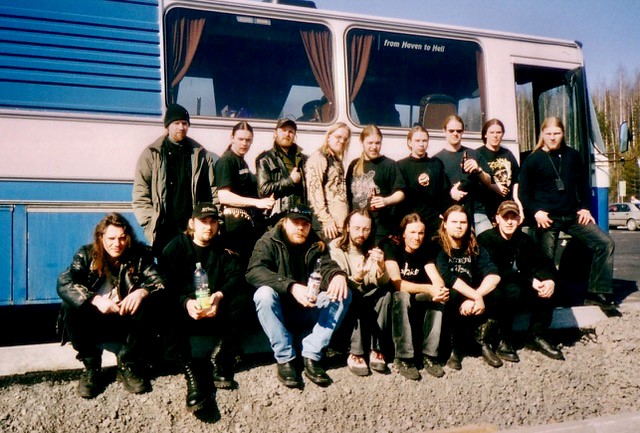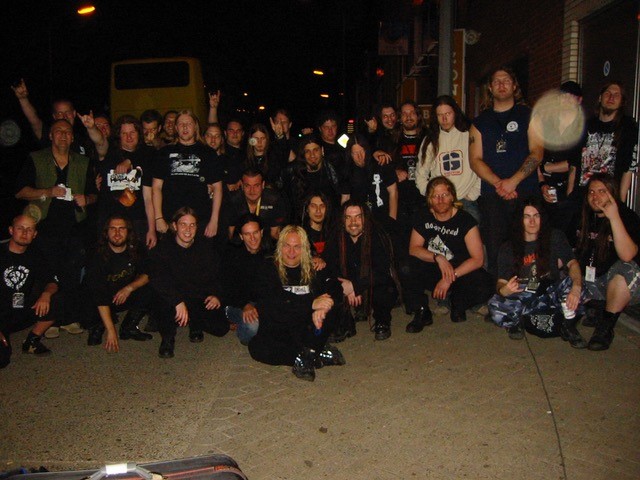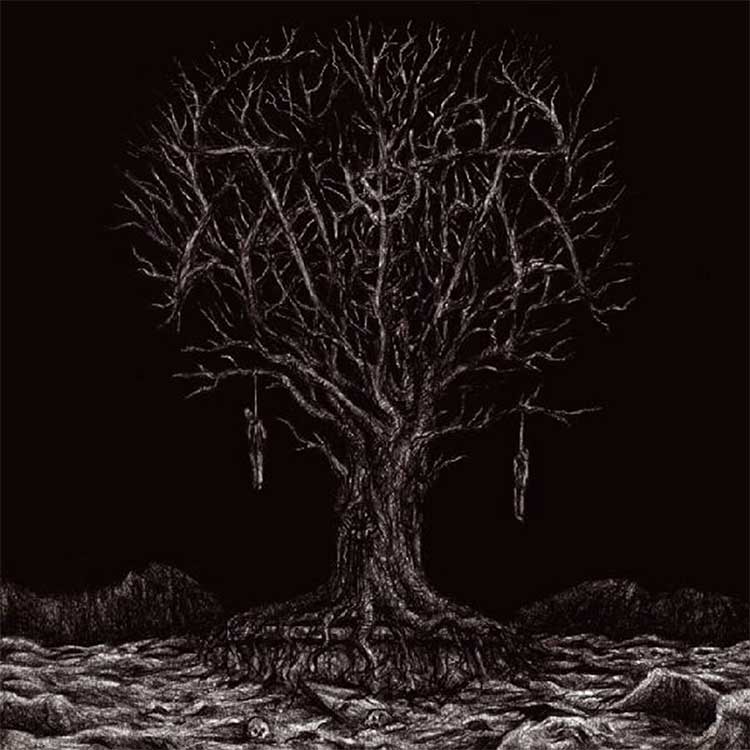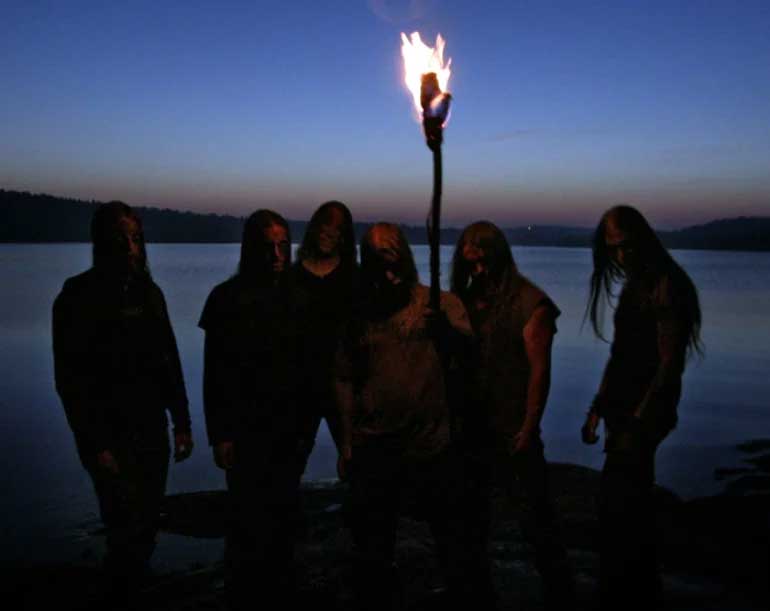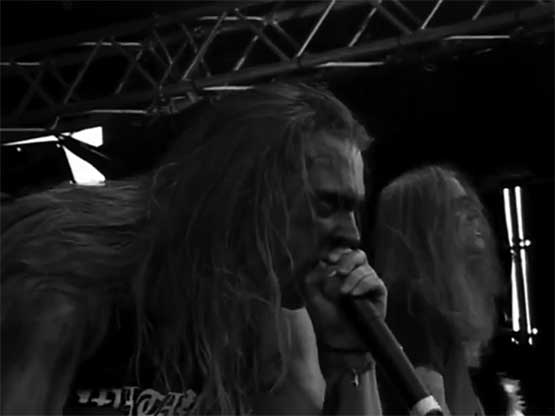Thyrfing II
2024-02-29
by Niklas Göransson
After the new millennium, Thyrfing recorded their landmark album Vansinnesvisor and came into their own as a live act. Following years of touring, as the gears started grinding to a halt, the phenomenon they helped shape took on a life of its own.
PATRIK LINDGREN: With the completion of “Vansinnesvisor”, the feeling was far from a sense of accomplishment. In fact, never before had we been so dissatisfied; it seemed to us as the worst THYRFING record to date. We were unprepared for the concept of an external producer, and the general consensus in the band was that someone had taken our precious work and ruined it.
“Vansinnesvisor”, THYRFING’s fourth album, was recorded at Dugout Productions in the autumn of 2001. In retrospect, it was almost a godsend that Tommy Tägtgren at Abyss Studio was unavailable at the time THYRFING wanted to record. Instead, they went to Dugout in Uppsala and worked with Daniel Bergstrand and Örjan Örnkloo.
PATRIK: It probably wasn’t until half a year afterwards, around the time of the album’s release, that I started coming to terms with it. I eventually realised that we’d brought THYRFING’s music to the next level and achieved something unique and distinct in terms of sound, lyrics, and overall concept.
How much can be attributed to the producers?
PATRIK: Of course, we owe much of this to Daniel and Örjan, but the fact remains that the material was written by us beforehand. It seems that we were already on the path to something different and simply needed a little guidance along the way. The torch of fast-paced and overly melodic music was left behind for others to pick up.
Musically, “Vansinnesvisor” was a significant shift from the first era of THYRFING – darker and more serious in tone, but without losing the key elements. I must say, it was a bold move to change the logo at the same time they re-invented their sound. Surely, as lifelong metalheads, they would’ve known what this entails.
PATRIK: Yes, that’s usually a good sign of things turning to shit, isn’t it? I honestly can’t recall if changing the logo was anything else than a sheer coincidence. Thomas and I were in charge of the visual aspects back then, and both of us felt a bit disillusioned after the “Urkraft” cover debacle. As a result, we decided to outsource all the layout work for “Vansinnesvisor”.
Enter Niklas Sundin, the lead guitarist of DARK TRANQUILLITY and proprietor of Cabin Fever Media. More recently, Sundin was tasked with the cover artwork for THYRFING’s 2021 album, “Vanagandr”.
PATRIK: Niklas was responsible for all aspects of the album’s visual design, including the artwork, typography, and photo editing. He also created a new logo that was an overall better stylistic fit. While the original is certainly a classic, it was difficult to incorporate into the “Vansinnesvisor” cover art. Looking back now, I can see how the change in sound, atmosphere, and logo all coincided with this album.
Following the release of “Vansinnesvisor”, THYRFING made up for their recent stage absence with a number of shows. One such example was a legendary November evening in Stockholm alongside DISMEMBER and, shall we say, a few other bands. Then, in December 2002, they did a Benelux mini-tour with CRUACHAN and SHADOWBREED.
PATRIK: If I recall correctly, the enthusiasm for playing live was generally low in the band after “Vansinnesvisor” came out. As you mentioned, we did some one-off shows in Stockholm alongside a strange mixture of bands, but it felt as if we just showed up because we had to; there was no sense of unity, purpose, or direction. However, the Benelux tour was a success, and we were slowly but steadily getting back on track with our live activities.
In April 2003, THYRFING embarked on a tour of Finland called Easter Disaster in the East. It makes perfect sense to pair them with Latvia’s SKYFORGER, but Finnish marauders BARATHRUM was an odd choice.
PATRIK: I suppose you have a point there. The tour was organised by someone from the opening band, LUCIFERASE, and the whole thing was carried out in what I’d describe as a one hundred per cent ‘punk and black metal spirit’. The hospitality rider consisted of homemade ‘wine’, and our sleeping arrangements were filthy mattresses on the floor of an old diesel bus. The venues were sleazy, and it seemed like everyone in both the audience and on the bill was completely wasted from start to finish.
I was present at the Turku show and can confirm that Patrik is not exaggerating. In fact, it’s part of the charm of Finnish underground metal.
PATRIK: Oddly, I’d say that this escapade was a turning point for us – in a positive way. Although such a lifestyle might not be desirable in our everyday lives, it felt like we found a home for THYRFING as a concert act. We discovered that relying on aggression, energy, and a bit of filth suited us better; more so than previous shows with power metal bands in perfectly clean leather pants, washed hair, and flawless playing. It was a revelation and became our lodestar. For the first time, we felt true confidence on stage and found a formula that we could refine and build upon going forward.
To this day, I curse myself for missing the Kuopio date – is it still your favourite THYRFING show?
PATRIK: Possibly. Without a doubt, one of the most intimate and energetic sets I’ve ever experienced. It was my first time in Kuopio, and when our bus arrived, it looked like a deserted ghost town. The venue was small and shitty, and I had a terrible hangover, so my expectations were not high. But as soon as the doors opened, the room filled up with crazed, shitfaced metalheads who… banged any head that didn’t bang? The show was bizarre; we were pushed into a corner that somewhat resembled a stage while the entire crowd went berserk, hanging from ceiling pipes and whatnot. It was reminiscent of the old VHS tapes from South American concerts I watched as a kid, but this one took place in northeast Finland.
I cannot imagine what touring with BARATHRUM mastermind Demonos Sova is like. To recycle a story from the COUNTESS feature in Bardo Methodology #4: one night in 2005, Chants of Evil organised a Stockholm concert featuring BARATHRUM, MORTUARY DRAPE, and UNPURE. The backstage was a small building adjacent to the venue’s entrance. When it was time for BARATHRUM to play, the doorman refused to let Demonos Sova in on account of him being outrageously drunk. It took some persuasion to convince the bouncer that this was, in fact, the frontman of the band about to play.
Following a few songs performed with varying degrees of intoxication-induced impairment, an initially verbal and then physical fight broke out on stage. After collectively leaving the venue, during which their guitarist punched a protesting audience member, they first split up the band and then began splitting up the backstage interior – prompting an intervention by Chants of Evil security, courtesy of Mörk from MALIGN. Once the teargas had cleared and tempers settled, BARATHRUM reformed and resumed drinking.
PATRIK: Yes, I can clearly see that happening. To be honest, we didn’t know much about the ‘legend’ of this band before the tour, so we had no idea what to expect. Maybe that was a good thing? But strangely enough, they were always respectful towards us. They seemed to enjoy our company for some reason, and the vibe was always good. Although there were some chaotic moments on the tour – like different line-ups each night and casual fistfights with other bands – things were relaxed between THYRFING and BARATHRUM. In fact, they even asked us to headline the last show, which we gratefully accepted.
The following month, in May 2003, THYRFING took part in the Generation Armageddon tour with ANCIENT RITES, PRIMORDIAL, SEPTIC FLESH, and SKYFIRE.
PATRIK: This tour had a great line-up on paper and started off well enough – but it took an unfortunate turn about halfway through when Jocke (Joakim) was flown back to Sweden due to acute bronchitis. We had to cancel the following two or three gigs. The remaining dates were played with SKYFIRE’s drummer for the first half of our set, and for the second half, Thomas played drums while Henrik took over on vocals.
Thomas, though primarily known as a vocalist, began his music career as the drummer for PANTHEON – a 90s black metal band that also featured Patrik and Joakim.
PATRIK: The touring troubles didn’t end there: ANCIENT RITES’ line-up imploded halfway through, leaving their guitarist and main songwriter stranded at a train station somewhere in mainland Europe. Despite having great potential, the tour ultimately turned into one big turmoil. Nonetheless, we received a good reception in Germany, SEPTIC FLESH in France, and ANCIENT RITES in the Benelux countries.
Following the release of “Vansinnesvisor”, THYRFING’s contract with Hammerheart expired. In 2004, they signed with Swedish label Regain Records.
PATRIK: That’s when Hammerheart renamed themselves Karmageddon Media and downsized in many ways, including moving offices. Both parties had fulfilled the contract, and when we asked them about the future, they were honest with us and said they couldn’t afford another THYRFING album. Looking back, our years with Hammerheart were pretty decent. They invested a lot in the band and helped put us ‘on the map’ in many ways. I can think of much worse labels to start out on.
It took three years – the longest gap between albums thus far – to follow up “Vansinnesvisor” with “Farsotstider”. This time, they recorded most of it at Cosmos Studios in Stockholm and then did additional tracking at the adjacent Zarathustra studio. That was an interesting move, seeing as how none of the engineers had worked with metal before.
PATRIK: Yeah, that was the point. We had this romantic idea of doing something totally different, hoping to get a unique sound that set us apart from other bands in the scene. The studio was almost legendary, with a classic sign you’d see when passing by on the subway. So, it all looked very promising. However, I can’t say that I’m thrilled with the production; it’s neat and clean but doesn’t add anything to the atmosphere. It’s a professional-sounding recording – nothing more, nothing less.
The song “Far åt helvete” was spontaneously spawned out of a rehearsal jam just before THYRFING entered the studio, yet it ended up as the album opener. On Spotify, it has three to four times more plays than most other tracks from “Farsotstider”.
PATRIK: Yes, “Far åt helvete” was for sure something that was more ‘tossed together’ compared to the meticulous crafting of most other songs. It can be a bit mind-twisting, and you never really get used to it… but oddly enough, music that comes together quickly and naturally tends to flow better and often ends up being more successful than something you labour with over numerous sessions.
This reminds me of a conversation I had with Swedish producer Dan Swanö. His BLOODBATH song “Eaten” – which is the band’s most popular composition by far, as well as the most renowned piece of music Swanö has ever written – was essentially improvised in the studio as a bit of a joke. Compared to all the efforts plied into something like NIGHTINGALE, that would presumably be a tough pill to swallow.
PATRIK: I think that’s a story you’ll hear from many bands … BLACK SABBATH’s “Paranoid” is probably the most notorious and oft-mentioned example. Personally, I’m terrible at estimating which songs would work as openers or be received well live. It usually turns out to be the complete opposite of my initial assumption.
Party San in 2006 was the last time I saw THYRFING live with Thomas as frontman. He departed on amicable terms the following year.
PATRIK: I was both surprised and saddened by Thomas’ departure. It was probably in the works for some time, but I obviously didn’t pick up on the signals. Although the mood within the band might not have been the best, I had no idea Thomas wanted to leave. There were some logistical issues as well; he’d moved to another part of the country, and his involvement with Sweden Rock Festival was increasing. And when he explained a few other reasons, it made perfect sense.
Replacing the band’s frontman after five albums is, by all accounts, an unenviable task. Especially a vocalist with such a unique voice and delivery.
PATRIK: I wouldn’t necessarily use the term ‘despair’, but losing your lead singer and most charismatic stage personality is certainly not a desirable outcome. Then, during a band meeting, Henrik announced that he was also leaving. The remaining four of us had a brief discussion, and everyone was determined to keep going. At the time, we saw it more as a minor setback than a major catastrophe. But I realise now that we faced a significant challenge there – but fortunately, we were too young and naive to notice.
log in to keep reading
The second half of this article is reserved for subscribers of the Bardo Methodology online archive. To keep reading, sign up or log in below.
